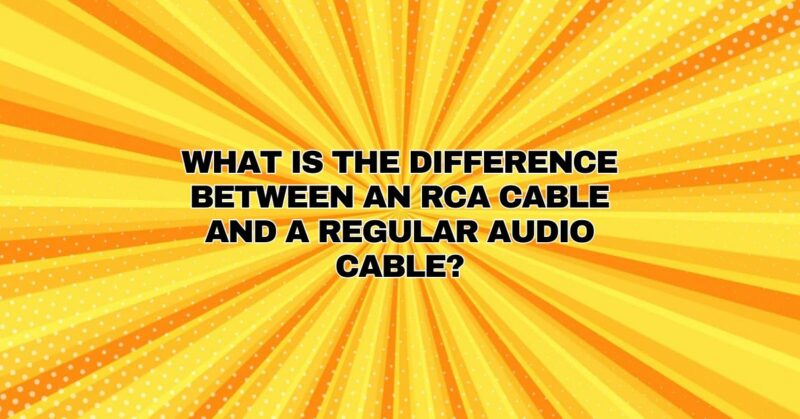Cables are the unsung heroes of the audio world, quietly transmitting signals from source to destination, whether it’s music from your favorite album or the sound effects in a blockbuster movie. Two common types of cables used for audio connections are RCA cables and regular audio cables. In this comprehensive guide, we will delve into the key differences between these two cable types, helping you understand their unique characteristics, applications, and how to choose the right one for your audio needs.
Understanding RCA Cables
RCA cables, short for Radio Corporation of America cables, are a type of connector and cable combination known for their distinctive red, white, and yellow connectors. They were initially developed by the Radio Corporation of America in the 1940s for transmitting audio and video signals. However, in the context of audio, the red and white connectors are the most relevant.
- Color-Coding: RCA cables use color-coding to distinguish between audio channels. The red connector typically represents the right audio channel, while the white connector represents the left audio channel. These connectors are sometimes referred to as “phono” connectors.
- Analog Signal: RCA cables are primarily used for transmitting analog signals. This means that they carry electrical representations of audio waveforms, which vary continuously over time. Analog audio is characterized by smooth, continuous changes in voltage.
- Stereo Sound: RCA cables are commonly used for stereo audio connections, where two separate audio channels (left and right) are transmitted. They are often employed in audio systems, home theaters, and various audio equipment.
Understanding Regular Audio Cables
Regular audio cables, often referred to as “audio interconnects” or “audio patch cables,” are a broad category of cables designed specifically for audio signal transmission. Unlike RCA cables, which have a distinct look, regular audio cables come in various forms, including cables with 3.5mm connectors, quarter-inch (6.35mm) connectors, and XLR connectors.
- Connector Types: Regular audio cables can feature different types of connectors, depending on their intended use. Common connector types include 3.5mm (1/8-inch) TRS (Tip-Ring-Sleeve), quarter-inch (6.35mm) TRS, and XLR connectors. Each connector type has specific applications and may be used in various audio equipment.
- Analog and Digital: Regular audio cables can transmit both analog and digital signals. While analog audio cables transmit continuous electrical waveforms (like RCA cables), digital audio cables carry discrete, binary data representing audio samples. Examples of digital audio cables include Optical (Toslink) and Digital Coaxial.
- Mono and Stereo: Regular audio cables can be used for both mono and stereo audio connections. Mono audio involves a single audio channel, while stereo audio has two channels (left and right). The choice of cable and connector depends on the specific audio configuration.
Key Differences Between RCA Cables and Regular Audio Cables
Now, let’s explore the primary differences between RCA cables and regular audio cables:
- Connector Types:
- RCA cables use the distinctive red and white (or yellow for video) phono connectors.
- Regular audio cables can have various connectors, including 3.5mm, quarter-inch (6.35mm), XLR, and more, depending on the application.
- Color-Coding:
- RCA cables use color-coding to denote audio channels (red for right, white for left).
- Regular audio cables typically do not rely on color-coding for channel identification, although some may have color-coded bands.
- Signal Type:
- RCA cables primarily transmit analog audio signals.
- Regular audio cables can transmit both analog and digital audio signals.
- Stereo vs. Mono:
- RCA cables are commonly used for stereo audio connections (left and right channels).
- Regular audio cables can be used for both stereo and mono audio connections, depending on the cable and connector type.
Choosing the Right Cable for Your Needs
Selecting the right cable depends on your specific audio setup and equipment. Here are some considerations to help you make the right choice:
- Cable Type: Determine whether you need an analog or digital audio connection. If you’re dealing with analog audio, consider whether you require a stereo or mono connection.
- Connector Type: Identify the connectors on your audio source and destination. If your equipment uses RCA connectors, use RCA cables. For other connector types, such as 3.5mm or XLR, choose regular audio cables with the corresponding connectors.
- Application: Consider the purpose of the connection. Are you connecting speakers, headphones, instruments, or other audio equipment? Different applications may require specific connector types and cable lengths.
- Signal Quality: For high-quality audio transmission, invest in cables with good shielding and connectors that minimize interference and signal loss.
Conclusion
RCA cables and regular audio cables serve as essential components in the world of audio connectivity, each with its unique characteristics and applications. While RCA cables are known for their color-coded connectors and analog audio transmission, regular audio cables come in various forms and can transmit both analog and digital audio signals. Understanding the differences between these cable types is crucial for making informed decisions when connecting audio equipment, ensuring that you achieve the desired audio quality and compatibility for your specific needs.


